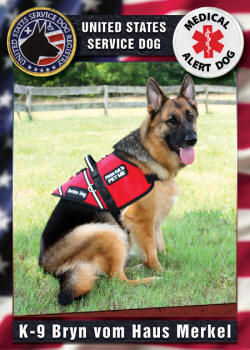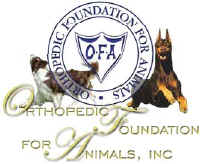|
MORE OF THIS ARTICLE
COMING SOON
|
Scroll WAY down for
Full Navigation
Basic Navigation on header |
|
|
COURAGE - CHARACTER - PREDICTABILITY
Show
puppies by Anatomy; Loyal Companions
and Protection by Nature; Health and Longevity by good
genetics; and proven by Health
Testing Certifications. Brought to you by a
thoughtful knowledgeable trusted
breeder of over 45 years.
Breeders of the finest quality Schutzhund/IPO
titled & Breed Surveyed German Shepherds in the United
States. Our breeding
program maintains
the integrity of the
German Shepherd's heritage to preserve the ideal human-canine bond.
"BREEDING HEALTHY DOGS BY DESIGN"
Our Merkel Geneology is from
Haßloch, Germany
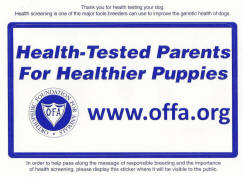

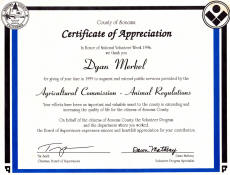

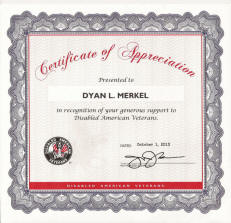
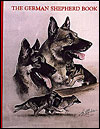 
We are published in these books
BREEDER
QUALIFICATIONS:
KENNEL NAME:
Haus Merkel
Breeder Name: Dyan
Merkel
Website:
http://www.hausmerkel.com
Location: North
Texas
Contact Info:
vhmerkel@yahoo.com
214-755-5755
HEALTH TESTS:
Hip/Elbow
Certifications: Yes
Degenerative Myopathy
Certifications: Yes
Thyroid tests: Yes
CERF tests: No
TRAINING:
Titles/certifies
breeding stock in
discipline?: Yes
BREEDING STOCK:
Raises breeding
stock from
puppies:
Yes
Titles dogs bred on
premise: Yes
Imports titled
breeding stock: Yes
Buys from other
Breeders: NO
MORE!
SCHUTZHUND/IPO:
Has trained in
Schutzhund: Yes
HOT from puppy to
SchH3: Yes
HOT and bred to
SchH3: Yes
CONFORMATION/BREED
SURVEY:
Show ratings: Yes
Breed
survey: Yes
BREEDER
ACCOMPLISHMENTS:
V Putz vom Haus
Merkel SchH3, Kkl 1a
V Ulla vom Haus
Merkel SchH3, Kkl 1a
V Zessa vom Haus
Merkel SchH2, IPO3,
Kkl1a
V Riesa vom Haus
Merkel SchH2, Kkl 1a
V Puma vom Haus
Merkel SchH2, Kkl 1a
V Emma vom Haus
Merkel SchH1, Kkl 1a
SG Wickie vom Haus
Merkel IPO1 a
SG Vessa vom Haus
Merkel IPO1 a
SG1 Clar vom Haus
Merkel SchH1 a
Ch Merkel's Opium
SchH1
V Merkel's Arletta
SchH1, a
SG, VP2 Nixe vom Haus
Merkel BH, AD, a
SG Feli vom Haus
Merkel BH, AD, a
Ch Merkel's Leica
UDT, OFA
Merkel's Leibchen
Shiloh UDT, OFA
Ch Merkels Sangria
UDT, OFA
United States
Grand Victrix
Ch
Merkels Vendetta ROM, OFA
Ch Merkel' Quaestor
CD, ROM, OFA
Ch Merkel's Essence
UD, OFA
Merkel's Coda vom
Jennerick CDX, OFA
National
Certified Search &
Rescue
Lieb vom Haus Merkel
OFA,
National
Obedience
Winner
Ch Merkel's Cut Up
of Timmee UDT, OFA
Certified United
States
Service Dog
Bryn vom Haus Merkel
CGC, OFA
Certified United
States
Service Dog
Fred vom Haus
Merkel
Ch Merkel's The
Cutting Edge OFA
Ch Merkel's Virtual
Reality OFA
Ch Merkel's Tequila
CD, OFA
Ch Merkel's Sante Fe
OFA
Merkel's Spellbound
ROM,OFA
Merkel's Emma ROM ,
OFA
Merkel's Estes CD,
near ROM
2009 Annual Achievement Award Recipient
Ch Merkel's Heart's are Wild
CDTDTC HIC CGC
TDI
OFA
Ch Merkel's Heart to
Heart CD, OFA
PRODOMINANT LINES
USED:
World Sieger Larus von Batu
SchH3 Kkl 1a
World Sieger Zamp vom Thermodos
SchH3, Kkl 1
World Sieger Yasko vom
Farbenspiel SchH3,Kkl 1a
VA Dux della
Valcuvia SchH3,
Kkl1a
Kirschental
WRITTEN GUARANTEE:
Yes
EDUCATION
AVAILABLE:
Yes
LIFETIME
SUPPORT:
Yes
YEARS AS BREEDER:
46
|
S I T E
N A V I G A T I O N
About our 56 years in the Breed
•
Our German Shepherd Males
•
Our German Shepherd Females •
Compare with other Breeders
•
Our References
•
German Shepherd Puppies for Sale
•
Older Puppies/Teenagers for Sale
•
Adult Females for Sale
•
Adult Males for Sale
•
Puppy Pricing/Contract
•
MORE LINKS:
Neutering your puppy
•
Deposit
•
Pricing,
Contract
•
Adult &Young
Males for Sale
•
Adult &Young
Females for Sale
•
Our German Shepherd Stud Dogs
•
Breeding Requirements for Stud
•
Puppy Mill Article •
German Shepherd Rescues •
Memorials
•
Articles
•
OFA •
Classifieds
•
Dog Food Analysis •
Worming &
Vaccination Schedule •
OUR OTHER PETS•
Excellent Link to pet/health videos
•
Any health care links located here
are NOT to replace a veterinarian visit; please take your dog to a vet
immediately at any sign of odd behavior or any symptoms of illness or
injury. Call your vet and describe your dog's symptoms with any of your
concerns about the dog's well-being. Your veterinarian may discover
changes in your dog's health that you have overlooked. It is always
better to err on the side of caution
HEALTH ARTICLES:
von Willebrand
Disease •
MORE ARTICLES:
Other Links
•
Links
•
Contact
•
Add your Link •
Members of
GSDCA
•
WDA
•
Schutzhund USA
•
My beloved mother
(Dorothy Conner Merkel
Obituary)
Love, kindness & laughter was her gift to all.
Always on my mind forever in my heart!
|
THIS IS WHAT WE FEED & RECOMMEND

Click photo to go to their site
VICTOR
SELECT HI-PRO PLUS
Calorie Content (calculated):
ME 3894 kcal/kg;429 kcal/cup
Formula for Active Dog &
Puppies contains high levels
of Proteins and Energy with only 30%
carbohydrates! This super premium food is
naturally formulated with added vitamins,
minerals and other additives that work
together to support a strong and healthy
immune and digestive system. As with all
Victor dog foods, this formula is free
from Corn, Wheat, Soy or Glutens and is also
made using GMO Free. Dogs love the
all natural flavor of this super premium
food
|
HOW TO GREET A DOG

Click on photo for the
BEST INFORMATION YOU CAN EVER HAVE ON MEETING OTHER PEOPLES
DOGS-Children really need to learn this.
READING A DOGS BODY LANGUAGE
attribution (C) DFDK9
www.dfdk9.com

Canine body language
http://dfdk9.wordpress.com/
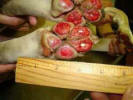
THIS is why you do not walk your dogs on asphalt or concrete
in the summer. If you see someone walking their dogs on
asphalt or concrete, PLEASE educated them and get the pet to
cooler ground. Original post was from Pet Ambulance Victoria
This should be sent to all the veterinarians including the specialists!

DOG PARK ALERT
We have received two notices.
(1) Nails wrapped in cheese at dog parks in Chicago and
Massachusetts (see pic). (2) from some friends that in
Augusta Maine dog park, antifreeze is being found in doggie
water bowls. Please beware and be careful and PLEASE SHARE
and spread the word

Ever wonder where puppy mill dogs come from? Here's an
example. Many get cooked alive in the sun and freeze to
death in the winter. If you purchase your dog from a pet
store, I can guarantee your "AKC" certified dog came from a
place like this. This one is even better than the ones
I saw in Iowa and Missouri!

Do you recognize she is a Yorkie?
Please do not purchase your pet from a Pet shop, Backyard
breeder or Commercial Puppy Mill.
|
ALL PETS RESCUES
needs your help! |
|
|
 |
|
"The man who rears a
dog must complete what the breeder began..." Max v. Stephanitz; Father of
the German Shepherd Dog
"Fun at the Beach"
 "Fun at
Work"
 "Fun
just hanging out"
|
BLOAT

Click chart to view larger version |
This is a real
combination of symptoms that spells out EMERGENCY. These are the classic
symptoms of a condition referred to as "bloat" - a dog that is pacing,
restless and has unproductive attempts to vomit.
This is a common problem in large breed
deep-chested dogs but can also occur in smaller dogs.
Basically what happens is this - the
stomach twists causing the blood supply to the stomach to be compromised
then leads to tissue death. As tissues are damaged, toxins are released
and a sequence of events occurs that if left untreated, leads to death.
If you ever notice these symptoms in
your dog, call your local veterinarian or emergency clinic as soon as
possible.
This is a condition that is fairly
common and often occurs in the evening or nighttime hours. It is also a
very expensive condition to treat.
READ MORE...
Dealing with Excessive Barking
The first step to stopping barking is to understand why it is
happening. Dogs bark for all kinds of reasons, including
anxiety, boredom and/or loneliness. Sometimes they bark just
because it feels good. Luckily, most dogs will respond to
one or other intervention to curtail their barking. Whether you
simply bring an outdoor dog inside or take the time to apply
behavior-modification techniques, you can cause a dog to be less
of a nuisance and to be more socially acceptable. |
Removing Skunk Odor
|
|
No need for the tomato juice. Use a mixture of 10 parts hydrogen
peroxide to 1 part baking soda. Add a dash of degreasing
dishwashing soap and pour into a spray bottle. Spray liberally
over dry coat and allow to air dry. Avoid eyes. Works on other
objects, too! |
Click link below to enjoy the Birding Site
FOR THOSE
WHO LIKE BIRDING
FDA DOG FOOD RECALLS
|
|
|
|
DEVELOPING
DRIVE IN YOUR GERMAN SHEPHERD PUPPY
FOR SCHUTZHUND WORK
Building Phases in the Protection Work for the Young
Dog (as printed in the September issue of
SV Zeitung 1981)
By Bernhardt Mannel, translated by Helga
FreyI want to talk about
"recognizing the drive and instincts, and the individual
building phases in the protection work with a young
dog". I would like to introduce you to a method which I
have advocated since 1965, In doing so I have
found many friends as well as many critics. I do
not believe in the saying "what the farmer doesn't know
he doesn't eat" so I have made a sincere effort to learn
about the facts that have been obtained through
scientific research and have put them into use in my
every day work.
The recognition of drives and
instincts is nothing new - but the certain 'know how' is
something that can only be derived from working with the
live animal, when we try to understand out dog. We
humans are able to think logically - our dog cannot, he
can only associate what is to his advantage.
Through the recognition of the
instincts and drives, and by working with them, we were
able to make use of the utility dog properties for out
protection training. As long as 80 years ago
Rittmeister von Stephanitz was the pioneer in this
field, as well as later on the police dog trainers Most
and Boettcher, who - in 1909 - broke away from the
humanization of the companion dog and introduced
training methods that are based on scientific research.
Dear Sportsfriends, these gentlemen were teachers who
were about 80 years ahead of their time!
From the infancy states of the
protection and utility dog we have now emerged into
today's dogsport. The requirements of the
protection work are laid out in the trial rule book,
wherein the helper in his protective clothing is the
central focus, and the sleeve is the bit target for the
dog; consequently, for the dog the sleeve is the prey -
for us the 100 points tare the desired training goal!
I want to talk only about the most
important factors, those which are the greatest help
toward that goal - and every dog handler should be able
to recognize them. I want to talk to you in the
language that every dog handler understands - the
language that seems to be understood universally when it
comes to dog training.
THE TEMPERAMENT
We evaluate the dog's temperament by
the way he reacts to the world around him. His
good disposition and natural way of interesting is only
a small part of it. The temperament is dictated by
his instincts and drives. His drives are brought
to the surface through (1) his own instincts and
(2) the stimulation he receives from the outside world.
If not channelled properly, these can develop into
uncontrollable behaviour towards his surroundings.
Let us start by watching the young dog
during the age where he is leaning to mind. The
puppy leaves the pack and is placerd with a new pack
leader - a person. Now starts the age where he
must lean to mind - which is strongly influenced by his
new pack leader. Within a period of 'getting to
know the puppy' and interacting with him, we recognize
his willingness for submission to his master. If
the dog only feels secure when he is near his handler,
this would indicate a strong development of his pack
instinct. Does the dog already show a tendency to
be able to occupy himself, does he discover the world
around him by 'using his nose', does he start to follow
tracks - if so, then this would indicate a strong
development of his scenting instinct which, even at this
early stage, should be encouraged. If the dog
scents with a high nose he is displaying a trailing
instinct. Does the dog show and interest in moving
objects, such as a ball, is he interested in other
things that move - then this would be a indication of
his yet unawakened prey instinct, which I should now try
to develop through his play instinct.
This means the dog learns to 'make
prey' . Through 'making prey' the dog develops his
self-confidence. By letting him have the prey he
experiences a feeling of success. His prey can be
a ball, a stick or a small sack. All this is done
at the age where he 'learns to mind;. His
'learning to mind' consists of a focus on the positive
instinct as as they pertain to the dogs' self-survival
instinct. I must encourage his drive to be active.
He receives his emotional strength through this muscle
strength and his temperament. The temperament is
expressed through his physical activity and the
enjoyment in whatever he is doing. The fighting
instinct is encourage through his play instinct and by
'making prey'.
We want to suppress the negative
traits during this age period. A developing
hinting instinct should be discourage by introducing an
alternate action such a playing with the ball. All
use of force which tends to develop the pack instinct
must be avoided at this stage. It is possible to
stop any drive or instinct development relatively
quickly when we can recognize it is starting to develop,
but it is already too late to stop it when the dog has
fully developed it! It would be rather negative to
encourage development of the pack instinct in the young
dog during this age period where he 'learns to mind'
which can be done by placing too much emphasis on
exaggerated obedience; this will only result in turning
a happy and positive dog into a subserviant one.
Later on this type of dog usually displays rather
negative tendencies in his protective drives and this
combined with a low stress level, results in the saying
'a young dog that barks a lot has a need for it.' The
young dog that displays and inner calmness usually is
well able to withstand the stresses that are place upon
him by the outside world. The amount of stress
that can be placed on a dog must be determined by
evaluating his nervous system and his emotional balance.
There should be no doubt that our dog has a soul and
experiences emotions. l No later than after
the dog has finished teething with he deal with his
surrounding on an emotional basis. Some avoidance
behaviour that was not apparent earlier may surface.
Things that the dog has not encountered before may
startle him. How effectively he can deal
with these things depends on his stress lever.
Quick excitement - which is outwardly indicated by the
dog having his hackles up, by growling, by the slightly
tucked tail - gives him an indication that he has a
tendency toward a low stress level, which is always and
adjunct of the dog's temperament. I need no
mention that in the overall framework of his
self-survival instinct, his flight instinct here is most
pronounced. Also, it the dog turns and runs from
whatever has startled him, this too should be recognized
as a negative trait. Here again, his low stress
level is the reason for his negative behaviour.
In contract to him the dog with the
medium stress level will get a hold of himself quickly
after something unknown to him has startled him., he
will usually assume a strutting position and will start
ot investigate what has startled him.
The dog with the high stress level
who, even at this young age, has a sound nervous system
will notice the startling object and then will accept it
as though nothing at all had happened.
To be able to recognize the stress
level in a young dog it an absolute MUST for good
helper work during the building phases of the protection
work with a young dog. Even now we can already
determine how much stress we can place on the young dog
at this age. A soft dog will appear quite
sensitive and will cater to the whims of his master
quickly, and he is prone to 'pout'; a hard dog will
retain his uninhibited and happy disposition with the
sane amount of stress being placed on him. Around
six months of age, sometimes sooner - sometimes later,
the dog will start to display his first protective
tendencies. These vary with the different working
or utility dog breeds. The first positive
behaviour is protecting his home or barking at
strangers. In contrast to this type of behaviour,
a display of over aggression , wanting to bite, hackles
up (these are mostly dogs who have a pronounce pack
instinct) is nothing other than a display of negative
traits in the course of his further development.
Those are the dogs that cover up their weaknesses by
becoming aggressive. May dog handlers in such a
case falsely believe that 'they have a tiger by the
tail'. Having a fight back only covers up the
dog's unsureness. The opposite is the case when we
do not know how to channel the dog's behavior into the
right direction through constructive discipline and
encouragement. Weaknesses will surface again and
again when the dog has been pushed beyond his stress
level.
Later on in the dog's further
development the puberty age will play an important part.
We cannot say exactly at what age this starts and when
it ends. We should watch our dog, and if we see
him 'act tough' around other dogs, when he starts to
lift his leg to mark his territory, that is usually an
indication. If he displays signs of unsureness
that are brought about by this puberty period, this
should not give us a reason to feel that there is
'something wrong with him'. Especially during the
teething period and the puberty period our dog needs our
understanding and our patience, and we must help him
over that precarious period in his life. Every dog
throughout his lifetime is more or less a product of his
handler - and there is good reason for saying 'like
master, like dog'.
By playing with our dog - through the
play instinct - we encourage his self-survival instinct,
his prey instinct and his self-defense instinct, his
instinct to fetch, we build his temperament and his
endurance - and it is also possible through; the play
instinct to eliminate certain insecurities. How
lucky is the dog with a pack leader who understands his
dog's emotional needs as opposed to the dog whose life
is spent in a kennel with only his own kind! |
|
This site
designed and maintained by Dyan Merkel of
DLM DESIGN STUDIO |

